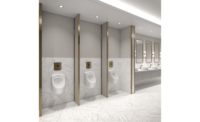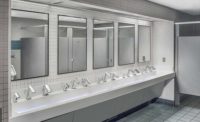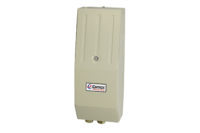It is important to find the right partner in many walks of life, including in bathroom design.
Most flushometer manufacturers report the 1.1 gpf options available for commercial restrooms could be “the basement” of low water usage and to receive the best performance, engineers and designers have to find the right toilet fixture fit.
“Paired performance is becoming a bigger concern,” says Bill Strang, president of operations and e-Commerce for TOTO. “Because when we design a porcelain solution, it will clean itself well and the flush valve is working ahead of the flush volume curve. You want water ahead of that dam of solid waste to provide buoyancy so it flows down. But, there has to be water behind it to provide energy to get it down.”
When discussing product innovations and design work with commercial engineers, Joel Marmion, a product manager of finish plumbing with Zurn, states the Milwaukee, Wisconsin-based manufacturer focuses on entire plumbing systems and how they work with Zurn flushometers — which recently added a 1.1 gpf diaphragm option.
Article Index:
“How do we improve the building’s performance and provide valuable data back to building owners?” he asks. “With buildings getting smarter, how do we provide solutions that make the plumbing system smarter? We have included QR codes on our flush valves to make it easier for facility maintenance to track the valves, maintain them and even order parts if necessary.”
Scott Delany, president and CEO of Charlottesville, Virginia-based Delany Products, says that pairing the right flushometer and toilet can come from anywhere. The products don’t have to be from the same manufacturer, calling it one of the “biggest fallacies in the industry.”
“The key to performance is pairing the right discharge flush valve with a high quality water closet,” he says. “After the choice is made, selecting a flush valve that provides the best features and benefits, allowing for ease of use, installation and repair is key.”
They’ve got the look
According to Marmion, architects are getting significantly more involved with the look of their bathrooms and taking a keen notice of flushometers. This development means engineers and manufacturers have to think about the flushometer’s aesthetics when selecting a unit for a project.
“Flushometers have a design that hasn’t changed much and now we’re looking hard at them,” Marmion says. “Let’s try and make them sexy. Why can’t we make it something to look at as well?”
Delany also believes architects and interior designers have an enhanced role in flushometer product selection. He sees this leading to a change in product development.
“You will see a move toward smaller-sized valves,” he notes.
Mike Gipson, a product manager of flushometers with Sloan, agrees the look of flushometers are critical, but a growing need for options that are “invisible” are rising.
“There is a growing trend to specify concealed flushometers, placing the product behind a wall for a cleaner aesthetic while providing less surface area to clean,” he says. “When a flushometer is not only dependable, but available in a variety of polished finishes, it creates a ‘best of both worlds’ product for engineers during the specification process.”
Adjustments made
Marmion notes that with lower flows being the new normal, manufacturers and engineers have to look to other components such as the carrier and the vitreous fixture for maximum performance.
“Zurn redesigned our carrier to pair with our low-flow valves to provide additional line carry,” he says. “We have re-engineered the vitreous to maximize rim wash as well as providing jet action to further enhance our line carry. The Zurn One system provides engineers with all that is necessary for a complete water closet installation.”
Marmion notes Zurn wall-hung toilets are the company’s highest-selling product and the units are paired with a carrier system. He says Zurn took a “hard look” several years ago at how the toilet and carrier system could provide the best performance possible.
“We looked behind the wall,” Marmion says. “The exit of a toilet is 2 1/2 inches and the carrier is 4 1/2 inches. This was a big gap where we did not get the velocity needed to push the waste down for proper line carry.”
Zurn shortened the throat of the carrier to “dial it in,” according to Marmion, and get the right velocity.
“That plays into our paired performance efforts,” he says. “We sell a system solution and give you all the components.”
Zurn was able to enhance its low-flow diaphragm flushometers to 1.1 gpf in the U.S., because the majority of the country has strong water pressure and excellent water quality.
TOTO uses mircoturbine technology in its low-flow commercial flushometers. On each use, the mircoturbine spins and generates the electricity needed to complete the flush. Strang notes its 15-year-old technology that continues to pay off for TOTO, engineers, building owners and end users.
“It is so durable and customers are impressed it continues to work,” Strang says. “These units only get changed out during a major bathroom remodel.”
Delany says that as water discharge rates have lowered, there has been an enhanced burden on the water closet to be more efficient and there is a desire to have a product that can be tweaked in the field.
“Products that provide field adjustability will become more and more critical,” Delany says. “These types of valves will provide what we call true-in-the-field water conservation or saving water in real-world situations.”
Stories to tell
With all the working parts in TOTO products, the manufacturer states it wants its customers to know its products “stories” and the manufacturer developed its own Sustainable Minds Reports. These reports, which are mobile-ready, can calculate a flushometer’s environmental and health impacts in real time.
“All the components are part of the overall transparency report. From cradle to grave,” Strang states. “We incorporate the energy required, the amount of water taken from an aquifer, etc. We understood the impact of the carbon footprint.”
Strang adds: “It shows the owner the amount of water usage, cost impact and more. There are no more secrets. So we said, let’s go ahead and step up to the plate to be as transparent as possible. You gain consumer loyalty on the professional and consumer side. We can tell a story that is compelling.”
Ronn Jefferson, a product manager with Geberit, says the company focuses on hospitality markets for flushometers where hotel chains are completely engrossed with the comfort of their guests.
“Simply review the advertising for the major hospitality companies and you’ll see their positioning is all around the comfort of the guest,” he says. “That makes the room’s toilet requirements even more demanding. How quiet is the flush? How reliable is it? Am I looking at the same old toilet on the floor or am I delivering a different experience?”
These hospitality applications are typically tied to sensors and electronics, Jefferson says, so Geberit thinks about the bigger picture.
“Sensors will fail,” Jefferson says. “And when there is a failure in the restroom or suite, the impact on the hotel brand is more significant than failure in any other area, including customer service.”
With growing populations and elevated concerns about water resources, TOTO’s Strang says his company and the industry can’t rest on any laurels.
“The worst thing we can be is complacent, we can’t slow down,” he says. “We all want to be Elon Musk and we want to take his approach. Let’s not be comfortable with the status quo.”
Strang also understands how engineers are getting worried about low-flow products and their feasibility in the field. He applauds the plumbing manufacturing industry on how hard it works to create a trust level with its products.
“Our industry works hard as a group to develop technology standards for low-flow products,” he says.
This article was originally titled “Carried away” in the April 2018 print edition of PM Engineer.








